If we had 30 seconds to describe Puppy Linux bluntly, we would classify it as an OS under the light-weight Linux distro family with a functional objective of creating a smooth and easy user experience while simultaneously minimizing the memory footprint usage as much as possible. In this context, the memory footprint refers to the RAM, or Main Memory is used while software like an Operating System is active or operational.
This 30-second assumptive description on Puppy Linux characterizes it as a Linux distro suitable for personal or home-user computers. If we are to assign it a birth year, then it would be 2003, and its creator being Barry Kauler.
Puppy Linux stands out in the Linux community despite its name not being hailed on regular occasions as other Linux distros like Ubuntu, Fedora, Centos, and Kali Linux. The respect it has in these user communities is due to its outstanding positive attributes on display.
We can list them as follows:
- It is always ready to go due to its pre-packaged default tools and features that meet a Linux user’s daily computing objective.
- It is flexibly adaptable to understand and certify it as grand-pa friendly with an emoji smile confidently.
- Puppy Linux has a relatively small and portable size such that you only need a 300MB storage space to carry it around comfortably.
- The distro’s ease of use and small size make it fast and versatile.
- Because you can understand its system’s layout in minutes, it takes the same amount of duration to customize it to your satisfaction comfortably.
- Puppy Linux is machine-adaptable in line with its different flavors that comfortably function or operate on new computers and old computers.
- This distro has a wide variety of puplets, which are derivatives created from it. The Linux users that seek a specific OS need can comfortably work with a puplet that serves this objective.
These positive attributes are what Puppy Linux offers on the table for the current and aspiring users that want to be a part of its Linux community.
If you want first to digest the Puppy Linux desktop environment’s first eye view, look no further than this screenshot of Slacko64 6.3.0 Puppy Linux Desktop Environment.
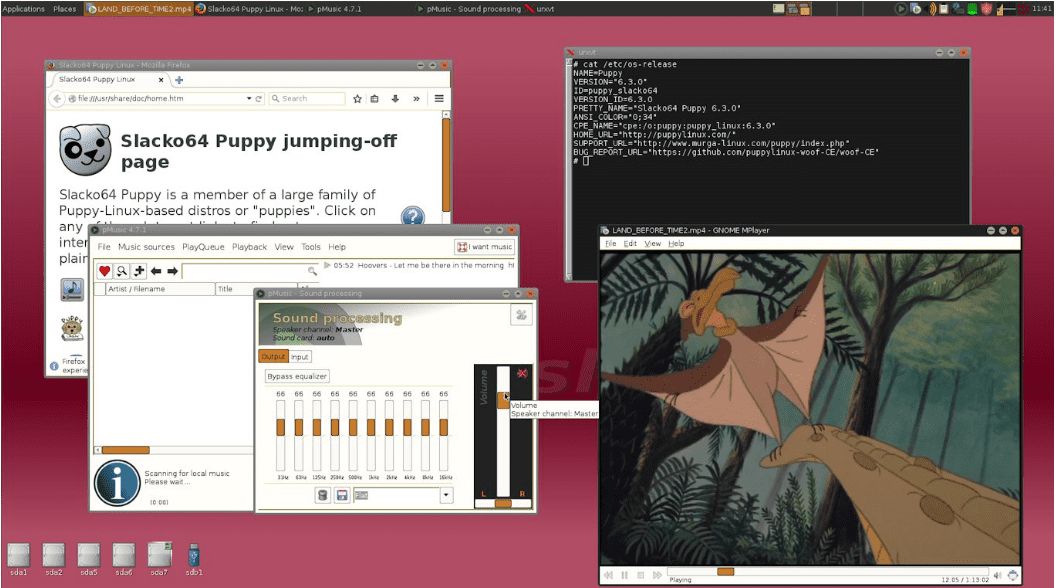
Slacko64 6.3.0 Puppy Linux Desktop Environment
Other official puppies exist beside Slacko64 and include Bionicpup64, Tahrpup, Slacko, and Tahrpup64. They are pre-packaged with awesome default apps like web browsers, audio, video players, feature-rich command-line utilities, share browsers, and networking tools. These official puppies are compatible with puplets that help combine and explore their desktop environments to improve user experience and preference. We can identify some of these puplets like Librepup, Lxpup, and X-Slacko. The puplets also prepackage their own browsers, audio and video players, word processors, file managers, and other desktop environment varieties.
Conceptualizing Puppy Linux
We are all familiar with Linux distros like Debian and Ubuntu. Puppy Linux is so uniquely different that we cannot categorically group it with these mentioned reputable Linux distros. Debian can stand alone as a single Linux distro, and Ubuntu can also stand alone as a single Linux distro but with multiple flavors like Xubuntu, Kubuntu, and Ubuntu Studio. When we use the Linux distro concept to define and categorize Puppy Linux, we arrive at an interesting statement. We can confidently state that Puppy Linux exists as a compounded Linux distro. It borrows specific applications and configurations, OS building toolsets, and shared development principals from multiple Linux distros to collectively compile and create its unique identity.
We can look at Puppy Linux as a hybrid Linux distro with multiple Linux distro DNA footprints collected from various Linux families. Despite this conceptualized definition, Puppy Linux managed to branch out and create three other recognized Linux distros. We can identify them with a few honorable statements.
Official Puppy Linux Distros:
The Puppy Linux team is responsible for its continuous development and maintenance. The Woof-CE Puppy Linux system builder contributed to the general build-up that defined and categorized it as a general-purpose Linux distribution.
Woof-Built Puppy Linux Distros
This category of Puppy Linux distros also serves the functionality of a general-purpose Linux system despite its developmental criterion or objective targeting specific user needs and user interface (UI) appearance and layout. The Woof-CE Puppy Linux builder is also responsible for its contributive build-up or development but employs additional modified packages to make it stand out distinctively.
Unofficial Derivatives or Puplets
These Puppy Linux distros are purpose-built hence their identity as remasters. The Puppy Linux enthusiasts community is responsible for its continuous development upgrades and maintenance. The distros listed under this category seek to serve a specific function like fusing the desktop environment of two puppies to form a puplet or creating Puppy Linux distro that is feature-reach in word processing, networking, or even network file sharing.
Puppy Linux Installation
You can engage with the officially available Puppy Linux Distros through the following download link. Once you have access to your preferred .iso file from the download link provided, you should proceed and make it bootable via your preferred installation media like a USB drive or CD-ROM. It is installable through an effortless and straightforward procedure. Once you can load its image at system boot time, navigate to the file directories under the .iso file. Open and explore it from the availed boot up system interface.
Access Application > Setup > Puppy Installer and execute or run it. You will notice that this installation procedure is alien to the methodologies used to install Ubuntu and Fedora’s likes. Once the Puppy installer launches, the expected installation interface should be similar to the following screenshot.
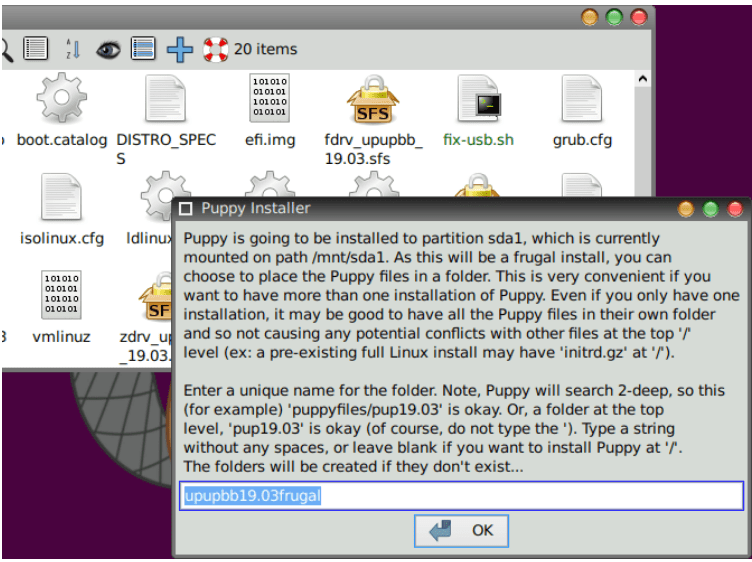
Puppy Linux Installer Launcher
Once the Puppy Installer launches, you will be comfortably guided step by step until your OS setup completes successfully. The succeeding installation step is obvious and entails creating and configuring a target installation partition for Puppy Linux. Make use of the Gparted partition manager program, which comes preinstalled with this setup, to create or configure the needed partition. The selected or created partition needs to have a root flag, an objective you can achieve by right-clicking on the partition drive.
Afterward, confirm your options regarding the selected installation partition drive before proceeding with the Frugal installation option. Under Frugal installation, an OS installation co-exists with another presently active OS without the need for a dual boot drive partition. A boot loader loads the Linux kernel first and then loads the initrd or initial ramdisk.
This installation approach creates a dedicated save file to store your personal settings, which improves your dual-booting performance. It saves you from considering full installation when the machine you are dealing with does not have performant CPUs.
Under this Frugal approach, each system shutdown requires the pre-existing system session to be saved. Still, this feature is not a downside as the lightweight nature of Puppy Linux makes it operationally acceptable without leading to any performance compromise. A saved session is named and encrypted to a desired storage path or location. Even if you opt to launch Puppy Linux under a live environment, it will still facilitate this functionality to save your user sessions.
The final step to completing your Puppy Linux installation setup is installing the Grub4dos tool, facilitating the installation of a boot menu. This boot menu is necessary to load the Puppy OS whether Puppy Linux is the only OS being installed or installing it alongside another Linux distro or flavor.
Puppy Linux Distro Releases and Popular Features
Slacko and Slacko64
We can count four years of repetitive developmental setbacks that haunted Slacko and Slacko64 official Puppies. The recent release of version 7.0 is a game-changer for its community users. The desktop environments of these official Puppies portray the Slacko64-7.0 default cover image.
As for the Slacko-7.0 with the 32-bit architecture, its UI environment specifically employs greyscale themes and backgrounds. The system and app icons maintain a colorful display or appearance to create a unique contrast. As long as these UI features are defined under an open-source Linux environment, nothing is permanent, and you have the flexibility to customize the OS to meet your UI preferences.

Slacko Puppy Linux UI
Slacko7’s official site offers more info on the relevant release notes and download links related to this Puppy version.
FossaPup64
Another interesting Puppy Linux community release is FossaPup64 9.5. The release of this Puppy into the Linux community goes hand-in-hand with Ubuntu Focal Fossa, a fancy popular name for Ubuntu 20.04 LTS. This relation is due to inclusive binary compatibility between this Puppy and Ubuntu 20.04 that enriches it with numerous compatible features. The popular ones include Kernel 5.4.53, JWM (Joe’s Window Manager), Palemoon browser, Hexchat, Rox filer, and modular build, making it possible to swap firmware, apps, and kernel in seconds. You can also achieve your desired networking protocols through samba and effective communication through Claws Email. Its release notes will unravel a broader perspective of the features this Puppy offers.
pMusic and Discography
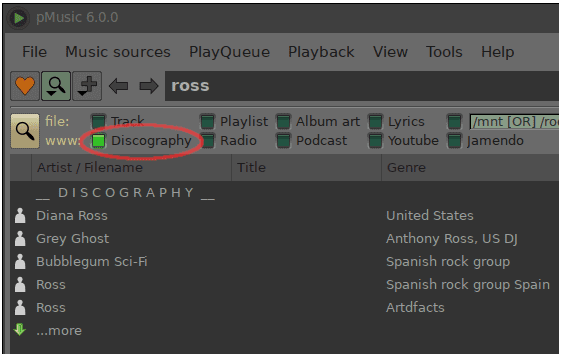
Puppy Linux Discography Feature
Every Puppy provides direct support and access to the pMusic app. This app accommodates the Discography feature. The dynamic functionality of this feature release is that a user can query musicbrainz.org and YouTube artist-databases and link it with the pMusic app making it a feature-invention with one in a million reputation. The feature comes with search functionality useful in querying a known artist linked with media content a Puppy user relates to or might want to bookmark. The combined functionality of pMusic and Discography enables a Puppy user to query and play music online from sites like Youtube or offline on a local collection.

Downloading YouTube Stream with pMusic
The next time you are using your Puppy to stream YouTube videos via pMusic, consider yourself lucky to have a direct YouTube stream download mechanism.
pMusic and Sound Processing
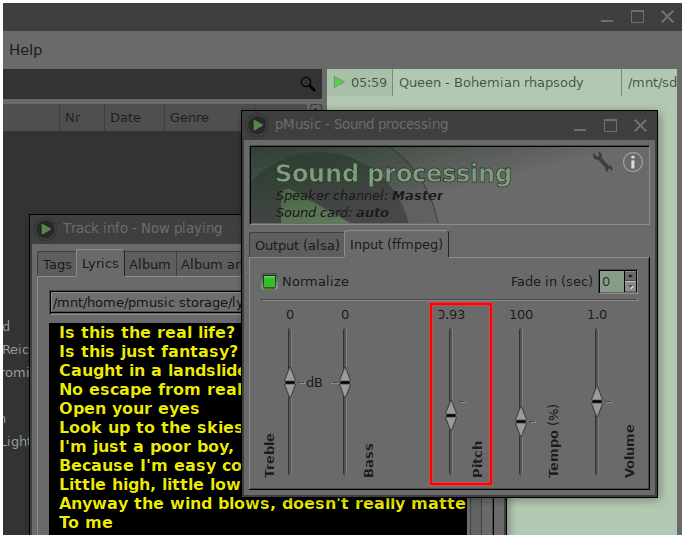
Using Puppy Linux for Sound Processing
The pMusic puppy app also accommodates a rich sound processing feature. It might not qualify it as an ideal Karaoke machine, but everyone today knows a thing or two about using the web to grab the lyrics of your favorite song. Since you can now edit your favorite media pitch, it is easy for music enthusiasts that look up to Freddie Mercury’s voice to sing along to their favorite music track comfortably. Now that we caught your attention on Puppy Linux’s usefulness to achieve seamless sound processing, you can learn more from this craft by following this Puppy blog.
pMusic and Podcast
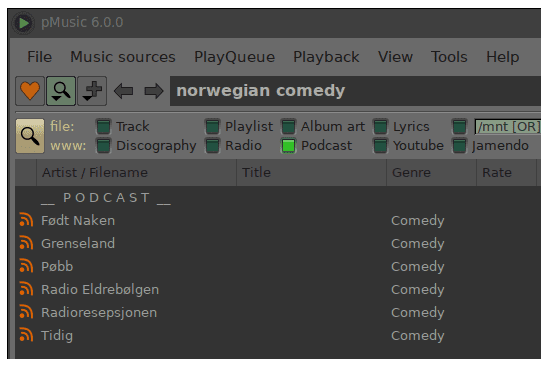
Puppy Linux Podcast Feature
The new version of pMusic offers some significant improvements on podcasting. The covered podcast channels are now at impressive 40000-plus channels, which meet the needed address verification protocols for their authenticity. Since we are dealing with a large data set, the navigation schematics also need to improve. The latter objective is achieved through the use of channel-linked info tags. Filtering search results regarding podcast channels is now a walk in the park through multiple and inclusive search criteria like topic, host, category, and language.
Puppy Linux Forums
John Murga is the name behind the resourcefulness and reliance of the first Puppy Linux forum, the old murga forum. The non-existence state of this forum or its possible existence under a read-only archive status does not in any way disadvantage the Puppy Linux community. Other alternate forums have begun to surface from late 2019 and are equally reputable in the offered resources and user assistance.
A forum known as the Puppy Linux Discussion Forum aims to be the new official forum for this distro as it hosts discussions, talks, and tips related to it.
Final Note
The highlighted features and improvisations regarding Puppy Linux are just a drop in the ocean of the awesomeness it brings back to the Linux community. The Puppy Linux hype has been low for some time, but the waves and tides from its discussion forums and support communities are beginning to rise. It is a lightweight Linux distro that insists on prevailing over its cool features and functionalities despite being small in size. You get to experience the pinch it takes from other multiple Linux distros responsible for its existence. If you doubt the performance specs of your current or old machine hardware, let Puppy Linux be the judge before you dismiss the usefulness of your machine hardware.
There are other lightweight Linux distros to consider apart from Puppy Linux.

